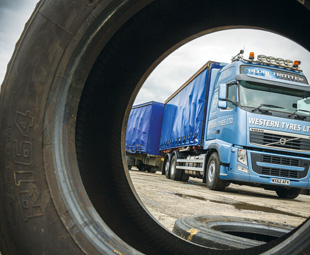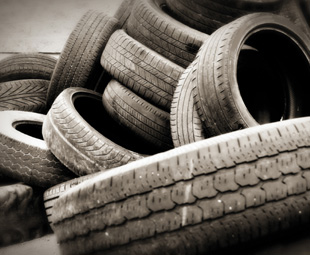Working tyre-lessly

In our November 2012 issue, FOCUS reported on the Retail Motor Industry Organisation (RMI) taking Redisa to court in order to delay the implementation of the latter’s waste tyre management plan. In the interim, the courts have found in favour of Redisa on all counts and the plan is to go ahead. CLAIRE RENCKEN investigates the merits of the Redisa plan.
It’s all about a resource revolution, explains Hermann Erdmann, CEO of Redisa: “In other words, it’s about what happens to the products at the end of their life cycle. There have been laws about this in South Africa since 1998 or 1999, but to date, this waste tyre management plan of ours is the first initiative, approved by government in South Africa, to spell the beginning of compliance to the waste management legislation.”
Over the next 15 to 25 years, there are going to be about three billion more middle class people straining our resources worldwide, of which there simply will not be enough if we don’t start getting resources from waste. This applies to all industries, not just tyres. If waste is managed efficiently, we could replace resources by up to 40 or 50 percent. Just as an example – 280 g of gold can be obtained from one tonne of cellphones.
“That is why an initiative such as ours is so necessary,” explains Erdmann. “A lot of ‘blood, sweat and tears’ went in to developing the plan. Redisa enlisted the aid of service providers that are leaders in their field, both nationally and internationally. They soon realised there was no existing category for waste stream management, which is when the dire need for a plan such as this became apparent.”
“I even presented our waste tyre management plan to the environmental minister of Denmark, and she felt that it is groundbreaking worldwide, not just in South Africa,” Erdmann enthuses.
Of course, for an initiative like this to work, it has to be run by an objective outsider – a tyre producer wouldn’t be able to raid its opposition or supplies of imported tyres to round up waste. That’s where Redisa came in. “The referee on the playing field can’t also be a player,” Erdmann says.
 “As an administrator Redisa can be strict. Producers will get an environmental rating from Redisa,” he adds. “So we can monitor, for example, that no aromatic oils are used in tyre production, which can produce carcinogenic compounds if tyres are not properly recycled.”
“As an administrator Redisa can be strict. Producers will get an environmental rating from Redisa,” he adds. “So we can monitor, for example, that no aromatic oils are used in tyre production, which can produce carcinogenic compounds if tyres are not properly recycled.”
All tyre shops have to be registered with Redisa, including government suppliers such as those that supply the army or correctional services, for example. This way Redisa will know where the suppliers are and how many waste tyres they are producing every month.
Producers (both local manufacturers and importers) are also required to pay R2,30 plus VAT per kilogram of tyres produced or imported, to motivate them to reduce the carbon footprint of tyres. “After all, this is not the responsibility of the consumer, but of the producer,” stresses Erdmann.
In terms of job creation, Redisa’s plan provides this by way of its transportation and storage needs. Small transporters can register with Redisa and be called upon to remove waste tyres – either to depots or recyclers themselves, depending which is closer, in order to minimise fuel consumption.
“Once we’ve completed the national roll-out, we will have to move about two million tyres a month. Of course, we need to find the best and most responsible secondary industry to use the waste – for example, using the rubber in the building of roads,” Erdmann continues.
“Like anything, this can’t happen overnight. Nobody has been doing anything about this waste for roughly 50 years; we can’t rectify that immediately, it will take two or three years. It takes two years just to build a recycling plant,” notes Erdmann. “But in building these plants, we are creating new businesses, all of which will be at least 51 percent black-owned and therefore BEE compliant.”
The South African tyre industry should be proud to be the first in the country to implement an integrated industry waste management plan. And it would seem that it is – big players such as Bandag and Michelin have supported Redisa from the beginning.
“We believe that, as the plan proves itself, more and more people will support it. By law, everyone is now expected to comply. Most suppliers are already on board. We are making it as easy as possible for people to register on our website now – similar to being able to do your e-filing online! About 200 importers and manufacturers have registered online, with minimal technical hitches,” Erdmann concludes proudly.
John Laskarides, MD of Bandag SA, states: “Aside from the court issues, it was precisely the need to comply with environmental legislation that motivated Bandag to be a Redisa member. We have gone further and have invested in our own crumbing plant in partnership with an external non-tyre related entity, and have been disposing of and recycling tyres since March 2012. Our moral responsibility towards the environment and the legislation has been satisfied, and we are proud to be the first tyre-related entity to have done so.”
Did you know?
• Waste tyres are among the largest and most problematic sources of waste, due to the large volume produced and their durability.
• Those same characteristics, which make waste tyres such a problem, also make them one of the most re-used waste materials, as the rubber is very resilient and can be re-used in other products.
• Approximately one tyre is discarded per person per year.
• Tyres are also often recycled for use on basketball courts and new shoe products. However, material recovered from waste tyres, known as “crumb”, is generally only a cheap filler material and is rarely used in high volumes.
• A big problem is the space required for storing and transporting scrap tyres, and the resulting costs.
• Recent developments in devulcanisation enable dealing with substantial volumes, taking 40-mesh whole-tire crumb and converting it into value-added compounds without degrading the polymer and without generating any pollution. This new generation of devulcanisation technologies operates with very high productivity, while maintaining a low energy footprint. The compounds produced from processed tyre scrap can be blended with virgin rubber compounds, maintaining performance while substantially reducing the raw material cost.
Published by
Focus on Transport
focusmagsa




